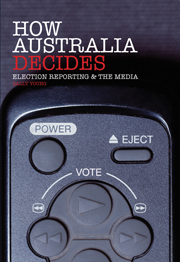Book contents
1 - Election reporting in the 2000s
Published online by Cambridge University Press: 03 May 2011
Summary
When the 2001 election was held, the Bulletin was still published. Nightline, Sunday and John Laws were still on air. The ABC website consisted of a string of text articles - no interactive maps, no video and no live vote-counting. The Packer family-with Kerry Packer in charge – still owned Channel Nine and the station was the undisputed ratings winner of the previous year. Only about 20 per cent of homes had pay TV (AFC 2005:62). Sky News existed but had not broadcast a dedicated election channel yet. Stephen Mayne's email newsletter Crikey had only begun the previous year. The Age and Sydney Morning Herald websites were updated irregularly. Wikipedia had only been in operation for a year. There was no YouTube and no Twitter. (They began in 2005 and 2006 respectively.) Blogging had begun in 1994 but ‘was not a recognised force in the political world’ and there was no social networking site ‘until Friendster in 2002, MySpace in 2003, and FaceBook in 2004’ (Schudson 2009:368).
It is not only media and technology that have been transformed. Reporting styles, journalism practice, audiences and the way politics is conducted have also changed. It will be a very different political reporting environment in another ten years' time. While we cannot anticipate all that will occur in the future, we can learn much by examining the recent past and thinking about how political reporting works, how it has changed and what we have both lost and gained in recent times.
- Type
- Chapter
- Information
- How Australia DecidesElection Reporting and the Media, pp. 1 - 20Publisher: Cambridge University PressPrint publication year: 2010

